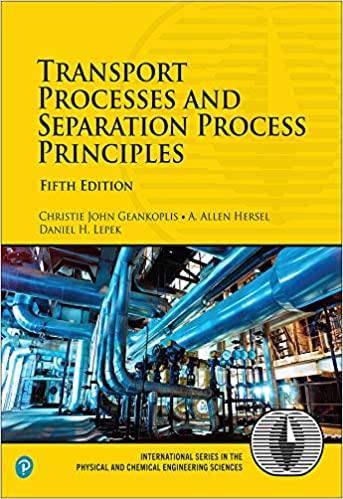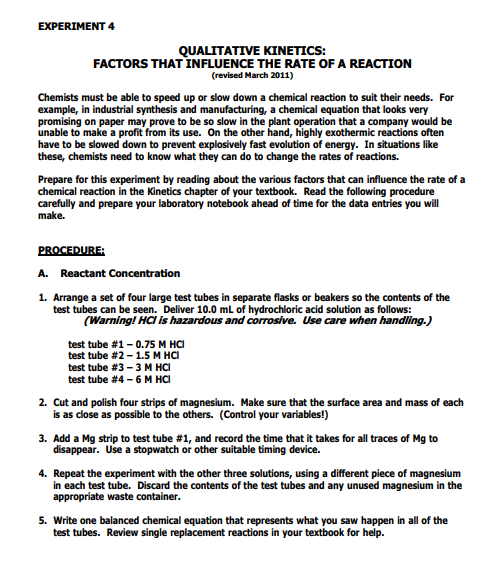
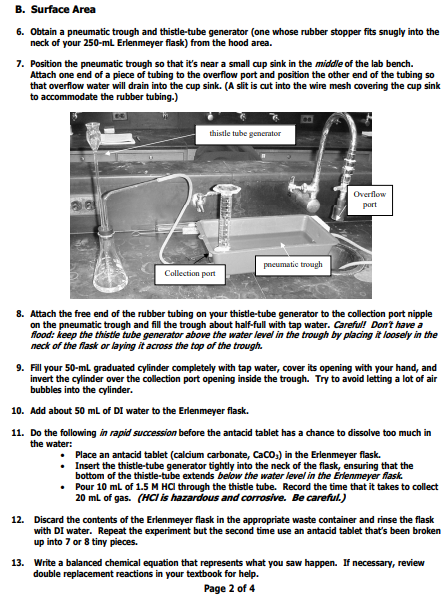
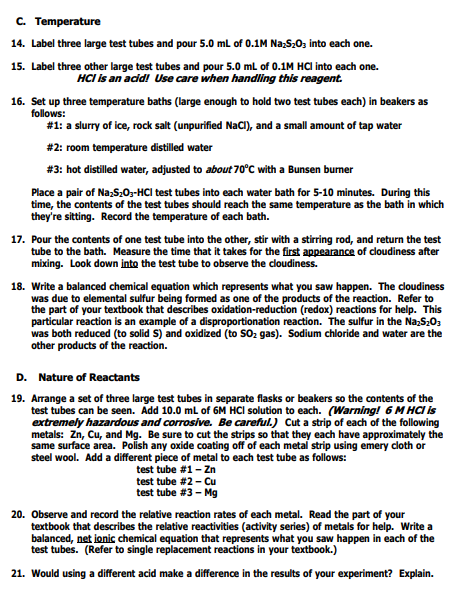
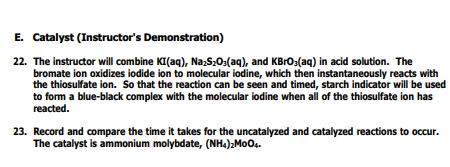
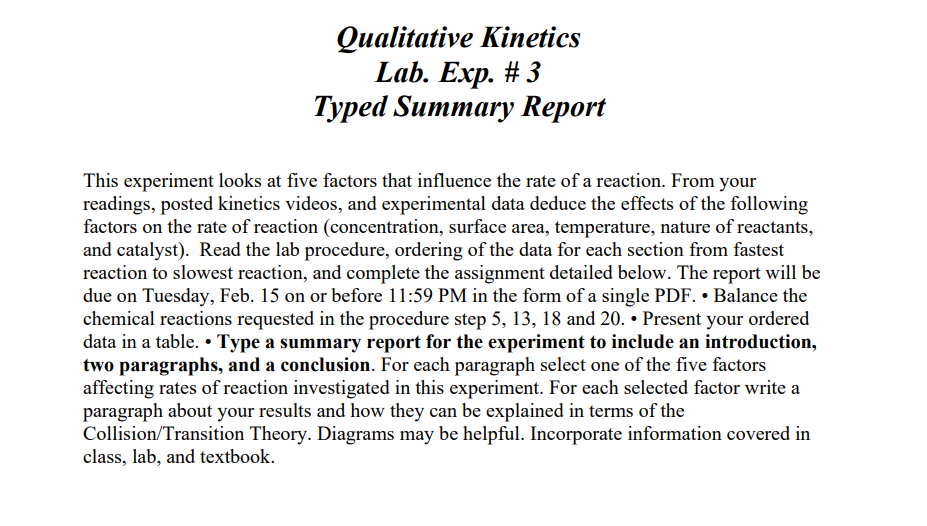
EXPERIMENT 4 QUALITATIVE KINETICS: FACTORS THAT INFLUENCE THE RATE OF A REACTION (revised March 2011) Chemists must be able to speed up or slow down a chemical reaction to suit their needs. For example, in industrial synthesis and manufacturing, a chemical equation that looks very promising on paper may prove to be so slow in the plant operation that a company would be unable to make a profit from its use. On the other hand, highly exothermic reactions often have to be slowed down to prevent explosively fast evolution of energy. In situations like these, chemists need to know what they can do to change the rates of reactions. Prepare for this experiment by reading about the various factors that can influence the rate of a chemical reaction in the Kinetics chapter of your textbook. Read the following procedure carefully and prepare your laboratory notebook ahead of time for the data entries you will make. PROCEDURE: A. Reactant Concentration 1. Arrange a set of four large test tubes in separate flasks or beakers so the contents of the test tubes can be seen. Deliver 10.0 mL of hydrochloric acid solution as follows: (Warning! HCl is hazardous and corrosive. Use care when handling.) test tube #1 -0.75 M HCI test tube #2 - 1.5 M HCI test tube #3 - 3 M HCI test tube #4 - 6 M HCI 2. Cut and polish four strips of magnesium. Make sure that the surface area and mass of each is as close as possible to the others. (Control your variables!) 3. Add a Mg Strip to test tube #1, and record the time that it takes for all traces of Mg to disappear. Use a stopwatch or other suitable timing device. 4. Repeat the experiment with the other three solutions, using a different piece of magnesium in each test tube. Discard the contents of the test tubes and any unused magnesium in the appropriate waste container. 5. Write one balanced chemical equation that represents what you saw happen in all of the test tubes. Review single replacement reactions in your textbook for help. B. Surface Area 6. Obtain a pneumatic trough and thistle-tube generator (one whose rubber stopper fits snugly into the neck of your 250-ml Erlenmeyer flask) from the hood area. 7. Position the pneumatic trough so that it's near a small cup sink in the middle of the lab bench. Attach one end of a piece of tubing to the overflow port and position the other end of the tubing so that overflow water will drain into the cup sink. (A sit is cut into the wire mesh covering the cup sink to accommodate the rubber tubing.) thistle tube generator Overflow port pneumatic trough Collection port 8. Attach the free end of the rubber tubing on your thistle-tube generator to the collection port nipple on the pneumatic trough and fill the trough about half-full with tap water. Careful! Don't have a flood: keep the thistle tube generator above the water level in the trough by placing it loosely in the neck of the flask or laying it across the top of the trough. 9. Fill your 50-ml graduated cylinder completely with tap water, cover its opening with your hand, and invert the cylinder over the collection port opening inside the trough. Try to avoid letting a lot of air bubbles into the cylinder. 10. Add about 50 mL of DI water to the Erlenmeyer flask. 11. Do the following in rapid succession before the antacid tablet has a chance to dissolve too much in the water: Place an antacid tablet (calcium carbonate, CaCO3) in the Erlenmeyer flask. Insert the thistle-tube generator tightly into the neck of the flask, ensuring that the bottom of the thistle-tube extends below the water level in the Erlenmeyer flask Pour 10 mL of 1.5 M HCl through the thistle tube. Record the time that it takes to collect 20 mL of gas. (HCl is hazardous and corrosive. Be careful.) 12. Discard the contents of the Erlenmeyer flask in the appropriate waste container and rinse the flask with DI water. Repeat the experiment but the second time use an antacid tablet that's been broken up into 7 or 8 tiny pieces. 13. Write a balanced chemical equation that represents what you saw happen. If necessary, review double replacement reactions in your textbook for help. Page 2 of 4 C. Temperature 14. Label three large test tubes and pour 5.0 mL of 0.1M Na2S-03 into each one. 15. Label three other large test tubes and pour 5.0 mL of 0.1M HCl into each one. HCI is an add! Use care when handling this reagent. 16. Set up three temperature baths (large enough to hold two test tubes each) in beakers as follows: #1: a slurry of ice, rock salt (unpurified NaCl), and a small amount of tap water #2: room temperature distilled water #3: hot distilled water, adjusted to about 70C with a Bunsen burner Place a pair of Na2S2O3-HCl test tubes into each water bath for 5-10 minutes. During this time, the contents of the test tubes should reach the same temperature as the bath in which they're sitting. Record the temperature of each bath. 17. Pour the contents of one test tube into the other, stir with a stirring rod, and return the test tube to the bath. Measure the time that it takes for the first appearance of cloudiness after mixing. Look down into the test tube to observe the cloudiness. 18. Write a balanced chemical equation which represents what you saw happen. The cloudiness was due to elemental sulfur being formed as one of the products of the reaction. Refer to the part of your textbook that describes oxidation-reduction (redox) reactions for help. This particular reaction is an example of a disproportionation reaction. The sulfur in the Na2S203 was both reduced to solid S) and oxidized (to SO2 gas). Sodium chloride and water are the other products of the reaction. D. Nature of Reactants 19. Arrange a set of three large test tubes in separate flasks or beakers so the contents of the test tubes can be seen. Add 10.0 mL of GM HCl solution to each. (Warning! 6 M HCl is extremely hazardous and corrosive. Be careful.) Cut a strip of each of the following metals: Zn, Cu, and Mg. Be sure to cut the strips so that they each have approximately the same surface area. Polish any oxide coating off of each metal strip using emery cloth or steel wool. Add a different piece of metal to each test tube as follows: test tube #1 - Zn test tube #2 - Cu test tube #3 - Mg 20. Observe and record the relative reaction rates of each metal. Read the part of your textbook that describes the relative reactivities (activity series) of metals for help. Write a balanced, net ionic chemical equation that represents what you saw happen in each of the test tubes. (Refer to single replacement reactions in your textbook.) 21. Would using a different acid make a difference in the results of your experiment? Explain. E. Catalyst (Instructor's Demonstration) 22. The instructor will combine Kl(aq), Na2S2O3(aq), and KBrO3(aq) in acid solution. The bromate ion oxidizes iodide ion to molecular iodine, which then instantaneously reacts with the thiosulfate ion. So that the reaction can be seen and timed, starch indicator will be used to form a blue-black complex with the molecular iodine when all of the thiosulfate ion has reacted. 23. Record and compare the time it takes for the uncatalyzed and catalyzed reactions to occur. The catalyst is ammonium molybdate, (NH4)2M004. Qualitative Kinetics Lab. Exp. #3 Typed Summary Report This experiment looks at five factors that influence the rate of a reaction. From your readings, posted kinetics videos, and experimental data deduce the effects of the following factors on the rate of reaction (concentration, surface area, temperature, nature of reactants, and catalyst). Read the lab procedure, ordering of the data for each section from fastest reaction to slowest reaction, and complete the assignment detailed below. The report will be due on Tuesday, Feb. 15 on or before 11:59 PM in the form of a single PDF. Balance the chemical reactions requested in the procedure step 5, 13, 18 and 20. Present your ordered data in a table. Type a summary report for the experiment to include an introduction, two paragraphs, and a conclusion. For each paragraph select one of the five factors affecting rates of reaction investigated in this experiment. For each selected factor write a paragraph about your results and how they can be explained in terms of the Collision/Transition Theory. Diagrams may be helpful. Incorporate information covered in class, lab, and textbook











